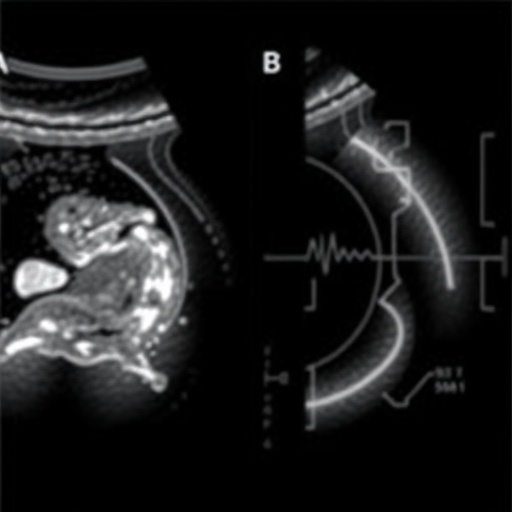In a remarkable advancement at the frontier of medical diagnostics, researchers have successfully harnessed the power of Doppler audio signals from the carotid artery. This innovative approach, aimed primarily at improving cardiovascular health monitoring, is the focus of an inspiring study by Gopal and colleagues, which sheds light on the nuances of carotid artery analysis. This study not only represents a significant technical achievement but also holds the potential to revolutionize how we approach cardiovascular diagnostics.
The carotid artery, a vital blood vessel that supplies blood to the brain, neck, and face, has long been a focal point for cardiovascular research. Atherosclerosis, or the buildup of plaque and fatty materials within the arteries, can severely impede blood flow, leading to serious health issues such as stroke. By tapping into Doppler audio signals, researchers aim to detect these abnormalities at an early stage. In their groundbreaking study, the team has employed advanced signal processing techniques that analyze the frequency shifts in sound waves produced by blood flow in the carotid arteries.
The intricacies of this research are noteworthy. Utilizing high-resolution Doppler ultrasound, scientists measured the frequencies of sound waves as they passed through the arteries. This technology captures the nuances of blood flow dynamics, allowing researchers to infer the presence of atherosclerosis and other vascular conditions with unprecedented accuracy. The study underscores the importance of early detection and continuous monitoring of arterial health, which could result in timely interventions and improved patient outcomes.
One of the standout elements of Gopal et al.’s research is their method of data collection. The team employed non-invasive Doppler ultrasound techniques in a clinical setting, minimizing any discomfort for the patients involved. This approach not only enhances patient compliance but also ensures that the data collected is reliable. With a growing emphasis on patient-centered care, these considerations are paramount in the development of new diagnostic tools.
In addition to the technical aspects of signal processing, the researchers also focused on the algorithms used to analyze the Doppler audio signals. They developed sophisticated computational models that enhanced signal clarity and interpretation, enabling the differentiation between normal and pathological states of the artery. As the researchers suggest, the integration of artificial intelligence within these algorithms could further augment their capabilities, paving the way for automated diagnostic tools that could be employed in various healthcare settings.
Furthermore, the implications of the findings extend beyond mere diagnostics. By fostering a better understanding of carotid artery physiology, Gopal and his team are contributing to the broader field of cardiovascular research. The insights gained from analyzing Doppler audio signals could inform the development of novel therapeutic strategies aimed at mitigating the risks associated with cardiovascular diseases. This holistic approach underscores the interconnectedness of medical research disciplines and highlights the potential for interdisciplinary collaboration.
As the study moves into the next phases of validation and clinical application, the potential for large-scale implementation becomes increasingly apparent. With the rise of telemedicine and remote health monitoring, the researchers envision a future where individuals can access real-time data about their vascular health from the comfort of their homes. This paradigm shift would not only empower patients but also significantly reduce the burden on healthcare facilities, allowing for targeted interventions where most needed.
Moreover, the research draws attention to the need for wellness-oriented healthcare practices. As cardiovascular diseases continue to be a leading cause of mortality globally, the focus on prevention and early detection becomes even more critical. By enhancing our understanding of carotid artery dynamics, this research encourages individuals to adopt proactive measures in maintaining cardiovascular health, such as lifestyle modifications and regular health screenings.
The potential for scalability is another vital aspect of this research. As healthcare infrastructure worldwide continues to evolve, the integration of such advanced non-invasive diagnostic techniques could promise improved outcomes across diverse populations. It offers a beacon of hope for regions that lack access to conventional cardiovascular diagnostic tools, ensuring that essential health measurements are within reach for everyone, regardless of geographic and economic barriers.
Furthermore, as Gopal and colleagues present in their study, there are broader ethical considerations underpinning the use of advanced technologies in healthcare. The integration of AI and machine learning must be approached with caution, ensuring that patient privacy is safeguarded while enhancing diagnostic processes. Establishing clear guidelines and standards will be vital for fostering trust in these new technologies as they are adopted more widely in clinical practice.
In summary, the research conducted by Gopal and his colleagues marks a paradigm shift in the way we approach cardiovascular diagnostics. Through the analysis of Doppler audio signals from the carotid artery, they have showcased significant advancements that promise to enhance early detection and treatment of vascular conditions. As more attention is drawn to the insights gleaned from this work, we can expect a ripple effect throughout the medical community, inspiring further research and innovation in the fields of cardiovascular health and beyond.
The promising findings from this study beckon a future where cardiovascular health monitoring becomes more accessible, personalized, and proactive. As we stand at the precipice of technological advancements in medicine, the commitment to enhancing patient outcomes through research like that of Gopal et al. will undoubtedly shape the future landscape of healthcare.
Subject of Research: Analysis of Doppler Audio Signals from the Carotid Artery
Article Title: Analysis of Doppler Audio Signals from the Carotid Artery
Article References: Gopal, T.V.V., Ghori, I., Eranki, A. et al. Analysis of Doppler Audio Signals from the Carotid Artery. J. Med. Biol. Eng. 45, 198–210 (2025). https://doi.org/10.1007/s40846-025-00934-7
Image Credits: AI Generated
DOI: https://doi.org/10.1007/s40846-025-00934-7
Keywords: Doppler audio signals, carotid artery, cardiovascular health, ultrasound diagnostics, signal processing, early detection, atherosclerosis, patient-centered care, artificial intelligence, telemedicine.




